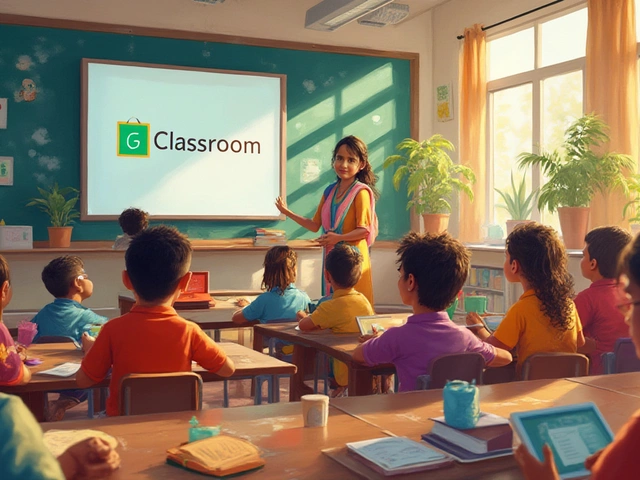Learning English can sometimes feel like diving into an ocean of words. Yet, with the right approach, it transforms into a fun and rewarding journey. The most efficient way to learn English involves not just traditional methods but also embracing technology, engaging with the culture, and practicing consistently.
In today's world, where borders blur but languages still bridge cultures, mastering English can open new doors and experiences. Whether you want to travel, advance your career, or simply connect with more people, becoming proficient in English is a valuable skill. Let's explore some strategies that make this learning process both efficient and enjoyable.
Interactive Learning
Interactive learning radically transforms the way we get familiar with new languages, especially English. It's not just about listening or reading; it's about engaging, questioning, and responding, which is incredibly powerful. One common method is participating in language exchange meetups where you meet native speakers eager to swap language skills. These sessions are informal and productive because you're forced to think on your feet and use the language in real-life scenarios. Each encounter becomes a mini adventure, weaving stories and making mistakes; that's where the true learning lies. Curiously, according to studies, interaction accelerates language acquisition, as it demands anticipation and responses similar to how we mastered our first language.
Another dynamic aspect of interactive learning is language gaming. Platforms offer various games that weave complex narratives with language tasks. Engaging your brain in puzzle-solving or role-playing games acts like a maze where vocabulary and grammar hide as rewards waiting to be discovered. It primes your attention in a fun way and entices you to keep going even after an exhaustive day. It's not just the young who find such methods intriguing; increasingly, adults return to these platforms to refresh or advance their English skills without feeling pressured. Amidst the captivating play, learning isn't a chore anymore; it's a quest brimming with delight and intellect.
Incorporating interactive videos is yet another strong tool in the language-learning arsenal. Platforms like YouTube offer a plethora of creators who steer audiences through conversational labyrinths and nuances of English. One standout channel is engVid, which provides lessons focused distinctly on everyday language subtleties. Here, the video pauses, the narrator questions you, and the learning becomes a dialogue rather than a monologue. According to a report on Language Efficacy, over 58% of learners find interactive video lessons more effective than traditional grammar-focused lectures.
The British Council states, "Interactive learning sets language in motion; learners are not just absorbing facts—they are shaping them." Such a profound shift from rote memorization to active participation in the learning process enhances retention and encourages deeper understanding.
Moreover, online platforms offering simulations of real-world situations act as brilliant interactive learning tools. Here, scenarios range from ordering a coffee in a bustling NYC café to negotiating business terms in a high-stakes meeting. These immersive experiences effectively prepare learners for the language's unpredictability, sharpening their linguistic reflexes. Artificial Intelligence is beginning to play a pivotal role too, creating more refined and relatable simulations that respond to input in real-time. The use of AI here represents the confluence of technology and linguistics, brewing an elixir promising faster learning and better retention.
It's no wonder that interactive learning is now a cornerstone of countless English learning strategies. Whether it's role-playing with fellow learners, indulging in an engaging game, or navigating a world through instructional videos, the value of interaction is undeniable. As English opens more global doors than ever, embracing this active approach could be your most impactful step toward fluency. Not only does it prepare you for real-life usage, but it also makes language learning an exciting adventure brimming with opportunities for authentic connection.

Immersive Environment
Creating an immersive environment is arguably one of the most powerful strategies for accelerating your English learning journey. Imagine if you could transform every moment of your daily life into a learning opportunity. One effective way to achieve this is by surrounding yourself with English in as many facets of your life as possible. Simple changes like switching the language settings on your electronic devices to English can expose you to everyday vocabulary and phrase structures. You begin to think in the language rather than translating from your native tongue to English, which significantly boosts your learning efficiency. In this transformation, your language learning becomes not a task but a lived experience.
Listening to English songs, podcasts, or audiobooks as you go about your day creates an auditory backdrop for learning. Music and spoken word bring not just language but also cultural nuances to life, helping you grasp the essence of expressions and idioms. Some experts argue that through consistent auditory exposure, your brain becomes more attuned to the rhythm, sound, and flow of the language, making it easier to understand and speak over time. Consider children's natural language acquisition process; they are constantly surrounded by the sounds of their native language, which helps them grasp the basics intuitively. Emulate this method by immersing yourself in the cadence of English daily.
Incorporating English into your reading habits can similarly enhance your learning. Subscriptions to online English newspapers or magazines enable you to digest information in English related to subjects you care about. This targeted reading can be compelling because it doesn’t just enhance vocabulary but also builds comprehension in a context that holds personal interest. Adventure into genres that entertain you, from mystery thrillers to historical biographies, where you might engage with the language more naturally. Even participating in book clubs or online forums centered around English literature provides valuable opportunities for interaction with other learners and native speakers, allowing for collaborative improvement.
Another engaging form of immersion is through watching English films or TV shows without subtitles. This method forces attentiveness to dialogue, body language, and visual cues, factors that enhance understanding. Surprisingly, TV shows often incorporate colloquial language and slang that are useful for real-life conversation. By absorbing and mimicking these phrases, you unknowingly build a portfolio of practical language skills. The key here is to choose content you genuinely enjoy; the more invested you are, the more naturally the learning occurs. Social media can also serve as an immersive tool. Following English-speaking influencers, joining discussion groups, or participating in live-streamed content can expose you to a wide array of dialects and conversational styles.
"The experience of learning a language is much richer and more enduring if learners are exposed to it within the context of real-life communication." – Language Learning Institute
Living in an English-speaking country provides an unparalleled immersive experience. However, if relocation isn't feasible, digital platforms offer alternative avenues to simulate immersion. Language exchange apps connect people from around the globe eager to help each other learn. Conversations with native speakers not only sharpen your language skills but also open doors to understanding different perspectives and cultures. Whether through online video calls or text chats, these exchanges can be highly encouraging and confidence-boosting.
Lastly, embracing the mindset that mistakes are part of the learning process can liberate you to use English more freely. An environment where you're comfortable making errors is truly an immersive one because it reflects real-life language use. Mistakes are stepping stones to mastery, providing lessons that reinforce learning. Engage in conversation without the fear of imperfection, and submerge the rigidity of traditional learning in an ocean of curiosity and exploration. This mindset shift changes your approach from learning to navigating a vibrant, living language.

Utilizing Technology
In today’s digital era, technology serves as both a tool and a companion on your journey to mastering the English language. The modern world offers countless opportunities to integrate digital resources into your learning regimen, transforming what used to be laborious rote learning into an engaging experience. One of the greatest advantages technology offers is accessibility. No matter where you are, be it at home or on the move, having access to learning platforms means every spare moment becomes a chance to practice and improve. From apps designed for vocabulary enhancement to interactive grammar exercises available online, technology can cater to every aspect of language learning.
Language apps like Duolingo and Babbel introduce gamification into education, turning lessons into quests and challenges. This format not only keeps learners motivated but also adds a layer of entertainment to mastery progression. These applications use algorithms to adapt to your pace, ensuring that each learner moves forward at their own speed. For those serious about integrating technology, incorporating a digital assistant like Alexa or Google Assistant into your practice routine can aid in pronunciation and provide instant translations or explanations. The development of such AI-driven tools is remarkable, providing real-time interaction that was once only conceivable in fiction.
For a more immersive experience, streaming services such as Netflix offer shows and films with subtitles, allowing learners to pick up colloquial expressions while enjoying their favorite genres. Changing subtitles can even serve as a comprehension test, switching from native language subtitles to English ones as understanding improves. TED Talks, available on YouTube, provide another rich source of modeled English presentation skills and academic vocabulary, valuable for advanced learners seeking to polish their proficiency in professional settings. With subtitles and transcripts freely available, viewers can track spoken words while reading along.
"Technology is best when it brings people together," said Matt Mullenweg, co-founder of WordPress, highlighting the potential for technology to connect learners across the globe.
Modern language learning can also integrate social media platforms and communication apps for practice. Engaging in direct conversations through apps like WhatsApp or joining English-speaking groups on Facebook can provide concrete practicing grounds that help apply the contents learned from structured lessons. Voice chat rooms or language exchange contacts found through platforms like Tandem or HelloTalk introduce conversational turns akin to real-life exchanges, essential for developing fluidity and natural linguistic flow. Though technology offers varied applications, finding the right balance between digital and traditional learning ensures a comprehensive language acquisition approach.
| Technology Tool | Function | Benefit |
|---|---|---|
| Duolingo | Gamified learning | Engagement through quests |
| Netflix | Films/Shows with subtitles | Immersive language exposure |
| HelloTalk | Language exchange | Practical conversation practice |

Finding the Right Course
When it comes to mastering a language, picking the right course is akin to finding the perfect recipe for a delightful dish. From bustling online platforms to community college classes, the variety can be overwhelming. But fear not, as selecting the most suitable English courses doesn't have to be a daunting task. First and foremost, it's essential to identify your goals. Are you learning English to enhance career opportunities, travel, or connect with new friends worldwide? Once clear on your aims, you can better navigate the options available.
Online educational platforms like Duolingo, Coursera, and Babbel offer a range of courses tailored to different learning styles and levels. Duolingo, for instance, gamifies the learning process, making it engaging while ensuring you build essential skills incrementally. In contrast, Coursera provides more structured courses, often designed in collaboration with top universities, offering a more academic approach. For those who thrive in a classroom environment, local colleges and language centers frequently run structured courses with face-to-face interaction, often beneficial for those seeking instant feedback.
According to a report by the British Council, “English is the most widely studied foreign language in the world.” This broad appeal means that the market is flush with options. Yet, this doesn’t necessarily translate to quality. Look for reviews and testimonials from previous students when considering a course. Often, a glance through these can provide insight into the course's actual value.
Research conducted by Cambridge Assessment English shows that students who engage in courses with real-life speaking activities tend to enhance their fluency remarkably faster.Thus, when choosing, think of courses that offer interactive sessions or opportunities to practice speaking with peers. In some cases, hybrid models that combine online learning with occasional in-person sessions offer the best of both worlds.
Understanding the logistics of your course is just as crucial. Can you fit it into your existing schedule? Many platforms now provide flexible learning models, allowing you to hop in and out of sessions as your timetable permits. This is ideal for those balancing work, family, and study, ensuring that learning English becomes an integrated part of life, rather than an added stressor. Consider courses that provide mobile compatibility, allowing you to practice on-the-go, turning commutes or lunch breaks into fruitful learning moments.
Cost is often a determining factor. While some platforms offer free introductory courses, advanced levels might require payment. Compare this with community courses or private tutoring to gauge what offers the best return on investment. However, remember that even a pricy course can be economical if it equips you with lifelong skills. Make sure to leverage free trials or introductory offers to get a feel of what’s best suited for your needs.
Here's a brief comparison of popular platforms and their features:
| Platform | Features |
|---|---|
| Duolingo | Free, gamified learning, mobile-friendly |
| Coursera | University-led courses, certification available |
| Babbel | Subscription-based, structured lessons, interactive exercises |
In essence, selecting the right course is a blend of understanding your unique needs, doing thorough research, and being open to experimenting with different formats until you find the right fit. As you set out on this linguistic adventure, remember that the most efficient language learning strategies rely not only on the quality of the course but also on your dedication and practice. Happy learning!












